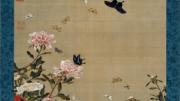Colorful Realm: Japanese Bird-and-Flower Paintings by Itō Jakuchū (1716–1800) was the seventh most-visited show in the National Gallery of Art's history, as measured by the number of visitors per day.
The exhibit, which closed April 29, drew an average of 7,473 visitors each day of its month-long run, placing it just ahead of the National Gallery's 1976 hosting of the international traveling exhibit Treasures of Tutankhamun.
The suite of Japanese nature paintings by the eighteenth-century painter Itō Jakuchū was temporarily loaned by the Imperial Household Agency of Japan to the National Gallery in order to commemorate the centennial anniversary of the National Cherry Blossom Festival. It was curated by professor of history of art and architecture Yukio Lippit.
All 33 paintings are rarely shown together, even in Japan, and the exhibition in Washington, D.C., marked the first time they had been displayed outside Japan.









